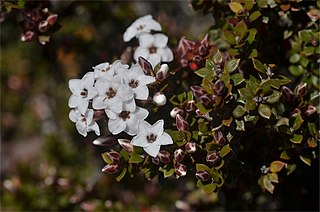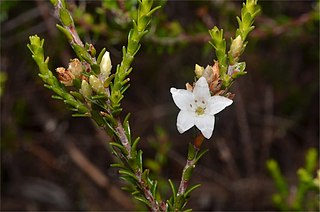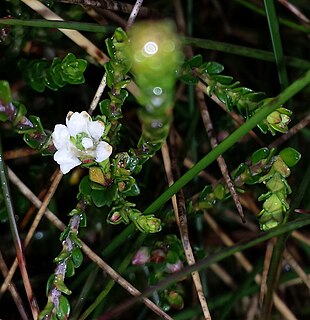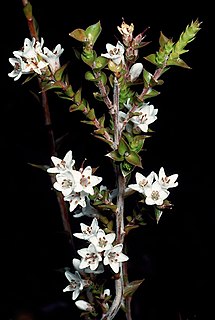
Epacris serpyllifoliais a species of flowering plant in the heath family Ericaceae and is endemic to Tasmania. It is a small low-lying or weakly erect shrub with heart-shaped to broadly egg-shaped leaves and tube-shaped white flowers crowded in upper leaf axils.

Epacris lanuginosa, commonly known as woolly-style heath, is a species of flowering plant in the family Ericaceae and is endemic to south-eastern Australia. It is a slender, erect shrub with hairy branchlets, linear to lance-shaped leaves, and tube-shaped, white flowers crowded along the ends of the branches.

Epacris petrophila, commonly known as snow heath, is a species of flowering plant from the heath family, Ericaceae, and is endemic to south-eastern Australia. It is an erect, bushy, sometimes low-lying shrub with egg-shaped to elliptic leaves and tube-shaped white flowers in small clusters on the ends of branches.

Epacris crassifolia is a species of flowering plant in the heath family Ericaceae and is endemic to south-eastern New South Wales, Australia. It is a low-lying shrub with elliptic to egg-shaped leaves with the lower end towards the base, and tube-shaped, white or cream-coloured flowers clustered near the ends of the branches.
Epacris apsleyensis is a species of flowering plant in the heath family Ericaceae and is endemic to a small area of Tasmania. It is an erect shrub with hairy branchlets, lance-shaped to elliptic leaves and tube-shaped flowers with white petals.

Epacris celata is a species of flowering plant in the heath family Ericaceae and is endemic to south-eastern continental Australia. It is a spreading to erect shrub with flat, elliptic to egg-shaped leaves with the narrower end towards the base, and tube-shaped white flowers clustered in upper leaf axils.

Epacris cerasicollina is a species of flowering plant in the heath family Ericaceae and is endemic to Tasmania. It is a shrub with lance-shaped to egg-shaped, slightly concave leaves and tube-shaped white flowers mostly clustered in upper leaf axils.

Epacris curtisiae is a species of flowering plant in the heath family Ericaceae and is endemic to north-western Tasmania. It is a shrub with egg-shaped to almost circular leaves and tube-shaped white flowers crowded in upper leaf axils.
Epacris exserta , commonly known as South Esk heath, is a species of flowering plant in the heath family, Ericaceae and is endemic to Tasmania. It is an erect shrub with narrowly lance-shaped to elliptic leaves and tube-shaped, white flowers clustered near the ends of the branches.

Epacris franklinii is a species of flowering plant in the heath family, Ericaceae, and is endemic to Tasmaina. It is an erect, spreading shrub with lance-shaped or elliptic leaves and white, tube-shaped flowers.

Epacris glabella, commonly known as smooth heath, is a species of flowering plant in the heath family, Ericaceae, and is endemic to Tasmania. It is a shrub with erect branches, egg-shaped to elliptic leaves and white, tube-shaped flowers.
Epacris grandis, commonly known as grand heath or tall heath, is a species of flowering plant in the heath family Ericaceae and is endemic to a small area of Tasmania. It is a robust, erect shrub with smooth stems, lance-shaped leaves and tube-shaped flowers with white petals.

Epacris graniticola, commonly known as granite heath, is a species of flowering plant in the heath family Ericaceae and is endemic to Tasmania. It is an erect shrub with egg-shaped leaves and tube-shaped white flowers mostly clustered near the ends of branches.
Epacris limbata, commonly known as bordered heath or border heath, is a species of flowering plant in the heath family Ericaceae and is endemic to a restricted area of Tasmania. It is an erect shrub with narrowly heart-shaped or broadly egg-shaped, stem-clasping, sharply-pointed leaves and tube-shaped white flowers clustered along the ends of branches.
Epacris lithophila is a species of flowering plant in the heath family Ericaceae and is endemic to a small area of New South Wales. It is an erect shrub with few branches, lance-shaped to elliptic leaves and creamy-white, tube-shaped flowers.

Epacris acuminata , commonly known as claspleaf heath, is a species of flowering plant in the heath family Ericaceae and is endemic to Tasmania. It is a small, spreading shrub with egg-shaped, stem-clasping leaves and tube-shaped flowers with white petals.

Epacris mucronulata is a species of flowering plant in the heath family Ericaceae and is endemic to Tasmania. It is an erect shrub with softly-hairy young branches, lance-shaped leaves, and cylindrical white flowers in small groups at the ends of the branches.
Epacris navicularis is a species of flowering plant in the heath family Ericaceae and is endemic to south-western Tasmania. It is a shrub with crowded, overlapping egg-shaped leaves arranged in five rows, and bell-shaped white flowers crowded in upper leaf axils.

Sprengelia propinqua is a species of flowering plant of the family Ericaceae, and is endemic to Tasmania. It is an erect, robust shrub with overlapping, stem-clasping, egg-shaped leaves, and white flowers crowded in upper leaf axils.

Epacris tasmanica is a species of flowering plant in the heath family Ericaceae and is endemic to Tasmania. It is an erect shrub with lance-shaped leaves and tube-shaped white flowers crowded in upper leaf axils.













